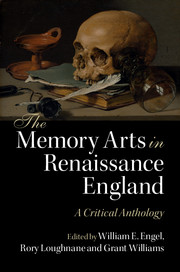Book contents
- Frontmatter
- Dedication
- Contents
- List of figures
- Acknowledgements
- A note on abbreviations
- Introduction
- PART I The art of memory
- PART II Rhetoric and poetics
- PART III Education and science
- Introduction to Part III
- III.1 Thomas Elyot, The Governor (1531)
- III.2 Roger Ascham, The Schoolmaster (1570)
- III.3 Levinus Lemnius, The Touchstone of Complexions (1576)
- III.4 William Kempe, The Education of Children (1588)
- III.5 John Brinsley, Ludus literarius (1612)
- III.6 Robert Burton, The Anatomy of Melancholy (1621)
- III.7 Thomas Sprat, The History of the Royal Society (1667)
- III.8 John Wilkins, An Essay towards a Real Character (1668)
- III.9 Obadiah Walker, Of Education (1673)
- III.10 Robert Hooke, ‘An Hypothetical Explication of Memory’ (1682)
- PART IV History and philosophy
- PART V Religion and devotion
- PART VI Literature
- Index
- References
III.3 - Levinus Lemnius, The Touchstone of Complexions (1576)
from PART III - Education and science
Published online by Cambridge University Press: 05 August 2016
- Frontmatter
- Dedication
- Contents
- List of figures
- Acknowledgements
- A note on abbreviations
- Introduction
- PART I The art of memory
- PART II Rhetoric and poetics
- PART III Education and science
- Introduction to Part III
- III.1 Thomas Elyot, The Governor (1531)
- III.2 Roger Ascham, The Schoolmaster (1570)
- III.3 Levinus Lemnius, The Touchstone of Complexions (1576)
- III.4 William Kempe, The Education of Children (1588)
- III.5 John Brinsley, Ludus literarius (1612)
- III.6 Robert Burton, The Anatomy of Melancholy (1621)
- III.7 Thomas Sprat, The History of the Royal Society (1667)
- III.8 John Wilkins, An Essay towards a Real Character (1668)
- III.9 Obadiah Walker, Of Education (1673)
- III.10 Robert Hooke, ‘An Hypothetical Explication of Memory’ (1682)
- PART IV History and philosophy
- PART V Religion and devotion
- PART VI Literature
- Index
- References
Summary
About the author and translator
Levinus Lemnius (1505–68) was a celebrated Dutch physician, whose medical writings were popular in England. He studied under the famous Swiss botanist and bibliographer Konrad Gesner at the University of Louvain and under the famous Flemish anatomist Andreas Vesalius at the University of Padua. Lemnius's De habitu et constitutione corporis was translated by Thomas Newton, an Anglican clergyman, who Englished some of Lemnius's treatises, as well as other contemporary continental and classical writings.
About the text
The Touchstone of Complexions sets forth Galen's theory of the different types of physiological constitution, which parse the sources of corporeal and mental infirmity. This medical perspective builds upon the Hippocratic understanding of the humours, the four bodily fluids whose intermixture was thought to determine relative health and psychological disposition. Each of the four humours derived from one of the four elements and its dominance in the body ultimately yielded one of the four mental temperaments: black bile corresponded to earth and the melancholic, yellow bile to fire and the choleric, phlegm to water and the phlegmatic, and blood to air and the sanguine. Philosophically speaking, the humoural microcosm replicated the larger elemental macrocosm.
Complexion – that is, physiological constitution – arose from the body's proportion of the four qualities of hot, wet, dry and cold, which characterised each element-derived humour, black bile being cold and dry, yellow bile being hot and dry, blood being hot and moist, and phlegm being cold and moist. When the body's qualities were excessive or deficient, the fluids became corrupted and putrefied, breeding dysfunction, disease and mental ailment. In Galen's scheme, there are nine complexions: only one with ideally proportioned qualities achieves ‘eucrasis’, a perfect blend, while eight are improperly blended, intemperate. Of the latter, four consist of simple qualities and another four consist of compound ones; for example, a hot and moist complexion makes for a sanguine person.
Galen's theory of fluidic physiology suggests that environmental factors could significantly alter the body's complexion. These factors were grouped under the category of the ‘six non-natural things’: diet, evacuation, air, sleep, exercise and rest, and the passions of the mind all exerted pressure on the proportion of the qualities and could thereby induce illness, or, when properly mustered through medical knowledge, restore health.
- Type
- Chapter
- Information
- The Memory Arts in Renaissance EnglandA Critical Anthology, pp. 156 - 159Publisher: Cambridge University PressPrint publication year: 2016



